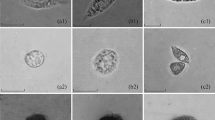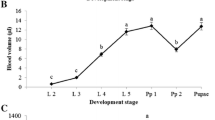Summary
One of the cell types occurring in the connective tissue of gastropods and bivalves is thepore cell. Cells of this type have a characteristic morphology in that their plasmamembrane has many invaginations bridged by cytoplasmic tongues. In the well developed granular endoplasmic reticulum and in these invaginations fine granular material, sometimes arranged in crystalline patterns, is present. InLymnaea stagnalis this material has been identified as haemocyanin on a morphological basis. Histochemical and ultrastructural results on pore cells of 2 snail species(Biomphalaria glabrata, Planorbarius corneus) having haemoglobin in their blood indicate that the pore cells in these species synthesize haemoglobin. Possible other functions of pore cells are briefly discussed.
Similar content being viewed by others
References
Baleydier, C., Nicaise, G., Pavans de Cecatty. M.: État fibroblastique et différenciation fibrocytaire des cellules conjonctives deGlossodoris (Gastéropode, Opisthobranche). C. R. Acad. Sci. (Paris)269, 175–178 (1969).
Buchholz, K., Kuhlmann, D., Nolte, A.: Aufnahme von Trypanblau und Ferritin in die Blasenzellen des Bindegewebes vonHelix pomatia undCepaea nemoralis (Stylommatophora, Pulmonata). Z. Zellforsch.113, 203–215 (1971).
Cheng, T.C., Rifkin, E.: Cellular reactions in marine molluscs in response to helminth parasitism. Amer. Fish. Soc. spec. publ.5, 443–496 (1970).
Cuénot, L.: Études physiologiques sur les gastéropodes pulmonés. Arch. Biol. (Liège)12, 683–740 (1892).
Cuénot, L.: L'excrétion chez les mollusques. Arch. Biol. (Liège)16, 4–96 (1899).
Dilly, P.N., Messenger, J.B.: The branchial gland: a site of haemocyanin synthesis inOctopus. Z. Zellforsch.132, 193–201 (1972).
Fernandez, J.: Nervous system of the snailHelix aspersa. I. Structure and histochemistry of ganglionic sheath and neuroglia. J. comp. Neurol.127, 157–182 (1966).
Jong-Brink, M. de: The effects of desiccation and starvation upon the weight, histology and ultrastructure of the reproductive tract ofBiomphalaria glabrata, intermediate host ofSchistosoma mansoni. Z. Zellforsch. (1973) (in press).
Meuleman, E.A.: Host-parasite interrelationships between the fresh water pulmonateBiomphalaria pfeifferi and the trematodeSchistosoma mansoni. Neth. J. Zool.22, 355–427 (1972).
Pearse, A.G.E.: Histochemistry. Theoretical and applied. London: I. & A. Churchill, Ltd. 1960.
Plummer, J.M.: Collagen formation in Achatinidae associated with a specific cell type. Proc. malac. Soc. (Lond.)37, 189–198 (1966).
Ruddell, C.L., Wellings, S.R.: The ultrastructure of the oyster brown cell, a cell with a fenestrated plasma membrane. Z. Zellforsch.120, 17–28 (1971).
Sminia, T.: Structure and function of blood and connective tissue cells of the fresh water pulmonateLymnaea stagnalis studied by electron microscopy and enzyme histochemistry. Z. Zellforsch.130, 497–526 (1972).
Stang-Voss, C.: Zur Ultrastruktur der Blutzellen wirbelloser Tiere. III. Über die Haemocyten der SchneckeLymnea stagnalis L. (Pulmonata). Z. Zellforsch.107, 141–156 (1970).
Straus, W.: Factors affecting the cytochemical reaction of peroxidase with benzidine and the stability of the blue reaction product. J. Histochem. Cytochem.12, 462–469 (1964).
Wigglesworth, V.B.: The pericardial cells of insects: analogue of the reticuloendothelial system. J. reticuloendoth. Soc.7, 208–216 (1970).
Wilbur, K.M., Yonge, C.M.: Physiology of Mollusca, vol. II. New York and London: Acad. Press 1966.
Wolburg-Buchholz, K.: Blasenzellen im Bindegewebe des Schlundrings vonCepaea nemoralis L. (Gastropoda, Stylommatophora): I. Feinstruktur der Zellen. Z. Zellforsch.128, 100–114 (1972a).
Wolburg-Buchholz, K.: Blasenzellen im Bindegewebe des Schlundrings vonCepaea nemoralis L. (Gastropoda, Stylommatophora). II. Aufnahme und Speicherung von Ferritin. Z. Zellforsch.130, 262–278 (1972b).
Wondrak, G.: Die Ultrastruktur der Zellen aus dem interstitiellen Bindegewebe vonArion rufus (L.), Pulmonata, Gastropoda. Z. Zellforsch.95, 249–262 (1969).
Author information
Authors and Affiliations
Rights and permissions
About this article
Cite this article
Sminia, T., Boer, H.H. & Niemantsverdriet, A. Haemoglobin producing cells in freshwater snails. Z.Zellforsch 135, 563–568 (1972). https://doi.org/10.1007/BF00583437
Received:
Issue Date:
DOI: https://doi.org/10.1007/BF00583437




